MGF1010 Essay: Approaches to Management in Different Sectors
VerifiedAdded on 2023/03/29
|8
|1812
|61
Essay
AI Summary
This essay examines the statement: "Despite aiming for vastly different goals, the approaches to management used in for-profit and not-for-profit organisations are largely similar." It begins with an introduction that outlines the purpose, scope, and structure of the essay, articulating the stance taken in relation to the essay statement. The body of the essay thematically analyses each issue under investigation, supporting arguments and viewpoints with evidence from reference materials, data, and examples. It explores the goals and management approaches of both for-profit and non-profit organizations, using the National Trust and Bakers Delight as case studies. The essay discusses integration, participation, and ecosystem-based management approaches in the non-profit sector and pre-classical and administrative approaches in the for-profit sector. The conclusion provides a concise summary of the findings, highlighting the implications and the future of the issue. The essay adheres to high standards of presentation, referencing, and formatting, including APA style and a comprehensive reference list. The essay argues the approaches to management are similar, despite the different goals of profit and non-profit organizations.

INDIVIDUAL ESSAY
Paraphrase This Document
Need a fresh take? Get an instant paraphrase of this document with our AI Paraphraser
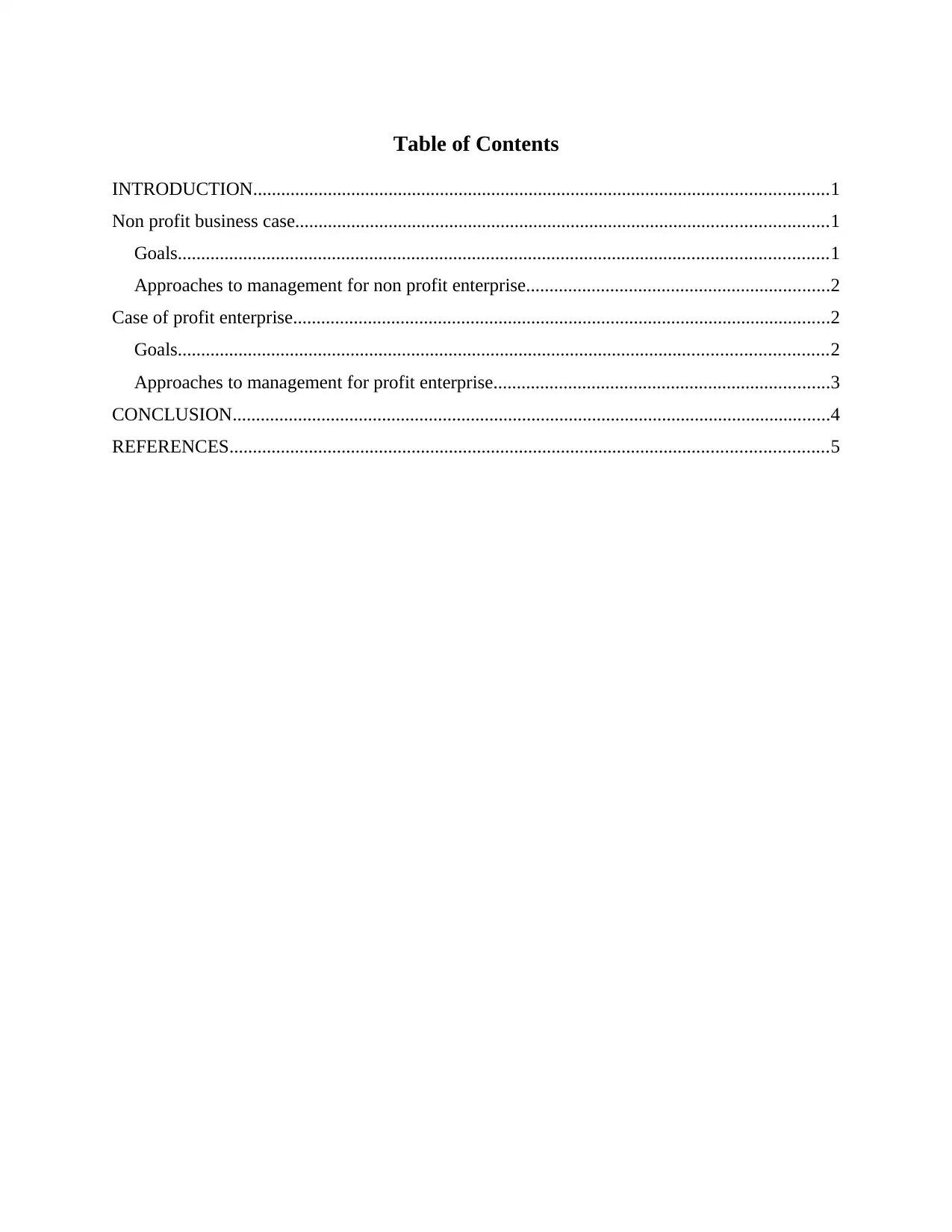
Table of Contents
INTRODUCTION...........................................................................................................................1
Non profit business case..................................................................................................................1
Goals...........................................................................................................................................1
Approaches to management for non profit enterprise.................................................................2
Case of profit enterprise...................................................................................................................2
Goals...........................................................................................................................................2
Approaches to management for profit enterprise........................................................................3
CONCLUSION................................................................................................................................4
REFERENCES................................................................................................................................5
INTRODUCTION...........................................................................................................................1
Non profit business case..................................................................................................................1
Goals...........................................................................................................................................1
Approaches to management for non profit enterprise.................................................................2
Case of profit enterprise...................................................................................................................2
Goals...........................................................................................................................................2
Approaches to management for profit enterprise........................................................................3
CONCLUSION................................................................................................................................4
REFERENCES................................................................................................................................5

⊘ This is a preview!⊘
Do you want full access?
Subscribe today to unlock all pages.

Trusted by 1+ million students worldwide
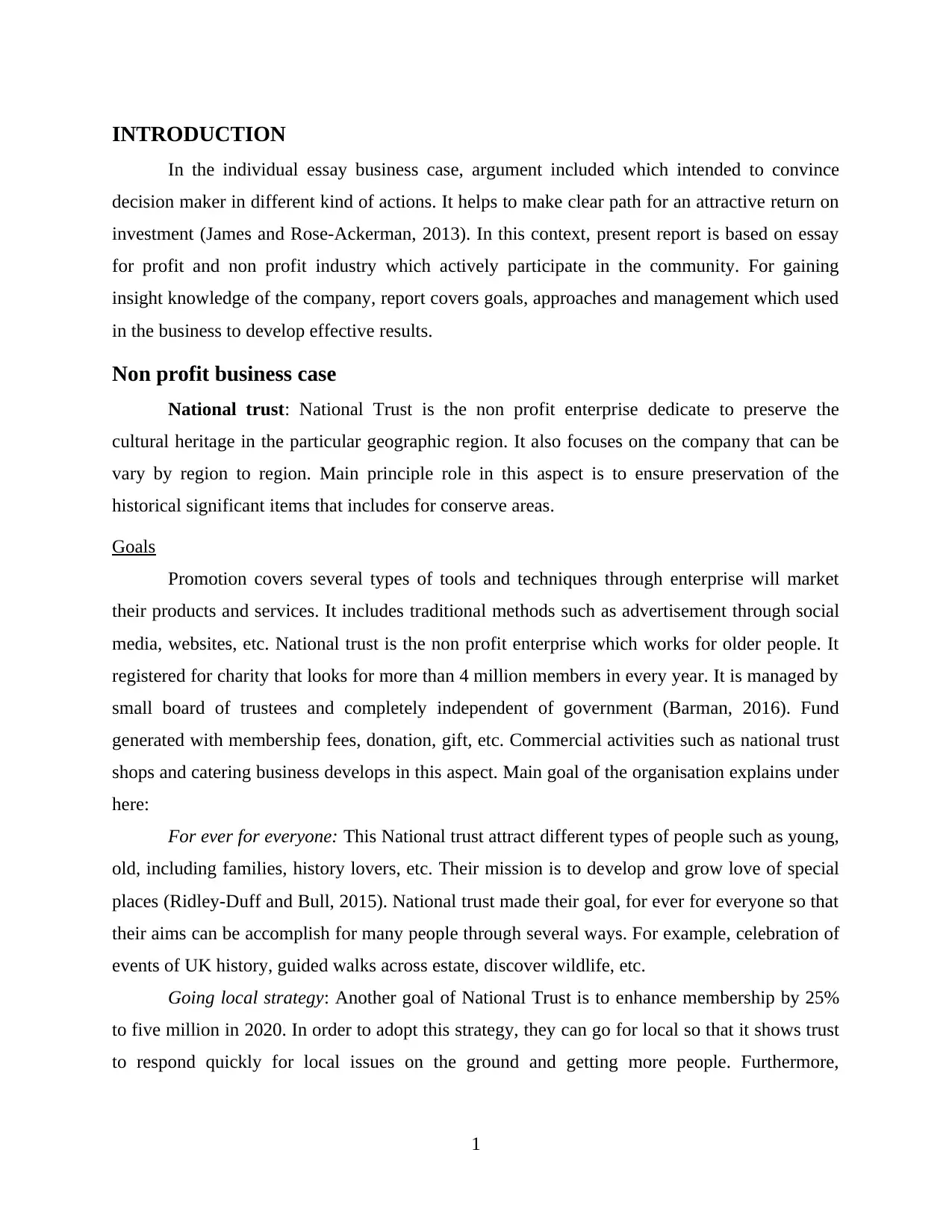
INTRODUCTION
In the individual essay business case, argument included which intended to convince
decision maker in different kind of actions. It helps to make clear path for an attractive return on
investment (James and Rose-Ackerman, 2013). In this context, present report is based on essay
for profit and non profit industry which actively participate in the community. For gaining
insight knowledge of the company, report covers goals, approaches and management which used
in the business to develop effective results.
Non profit business case
National trust: National Trust is the non profit enterprise dedicate to preserve the
cultural heritage in the particular geographic region. It also focuses on the company that can be
vary by region to region. Main principle role in this aspect is to ensure preservation of the
historical significant items that includes for conserve areas.
Goals
Promotion covers several types of tools and techniques through enterprise will market
their products and services. It includes traditional methods such as advertisement through social
media, websites, etc. National trust is the non profit enterprise which works for older people. It
registered for charity that looks for more than 4 million members in every year. It is managed by
small board of trustees and completely independent of government (Barman, 2016). Fund
generated with membership fees, donation, gift, etc. Commercial activities such as national trust
shops and catering business develops in this aspect. Main goal of the organisation explains under
here:
For ever for everyone: This National trust attract different types of people such as young,
old, including families, history lovers, etc. Their mission is to develop and grow love of special
places (Ridley-Duff and Bull, 2015). National trust made their goal, for ever for everyone so that
their aims can be accomplish for many people through several ways. For example, celebration of
events of UK history, guided walks across estate, discover wildlife, etc.
Going local strategy: Another goal of National Trust is to enhance membership by 25%
to five million in 2020. In order to adopt this strategy, they can go for local so that it shows trust
to respond quickly for local issues on the ground and getting more people. Furthermore,
1
In the individual essay business case, argument included which intended to convince
decision maker in different kind of actions. It helps to make clear path for an attractive return on
investment (James and Rose-Ackerman, 2013). In this context, present report is based on essay
for profit and non profit industry which actively participate in the community. For gaining
insight knowledge of the company, report covers goals, approaches and management which used
in the business to develop effective results.
Non profit business case
National trust: National Trust is the non profit enterprise dedicate to preserve the
cultural heritage in the particular geographic region. It also focuses on the company that can be
vary by region to region. Main principle role in this aspect is to ensure preservation of the
historical significant items that includes for conserve areas.
Goals
Promotion covers several types of tools and techniques through enterprise will market
their products and services. It includes traditional methods such as advertisement through social
media, websites, etc. National trust is the non profit enterprise which works for older people. It
registered for charity that looks for more than 4 million members in every year. It is managed by
small board of trustees and completely independent of government (Barman, 2016). Fund
generated with membership fees, donation, gift, etc. Commercial activities such as national trust
shops and catering business develops in this aspect. Main goal of the organisation explains under
here:
For ever for everyone: This National trust attract different types of people such as young,
old, including families, history lovers, etc. Their mission is to develop and grow love of special
places (Ridley-Duff and Bull, 2015). National trust made their goal, for ever for everyone so that
their aims can be accomplish for many people through several ways. For example, celebration of
events of UK history, guided walks across estate, discover wildlife, etc.
Going local strategy: Another goal of National Trust is to enhance membership by 25%
to five million in 2020. In order to adopt this strategy, they can go for local so that it shows trust
to respond quickly for local issues on the ground and getting more people. Furthermore,
1
Paraphrase This Document
Need a fresh take? Get an instant paraphrase of this document with our AI Paraphraser
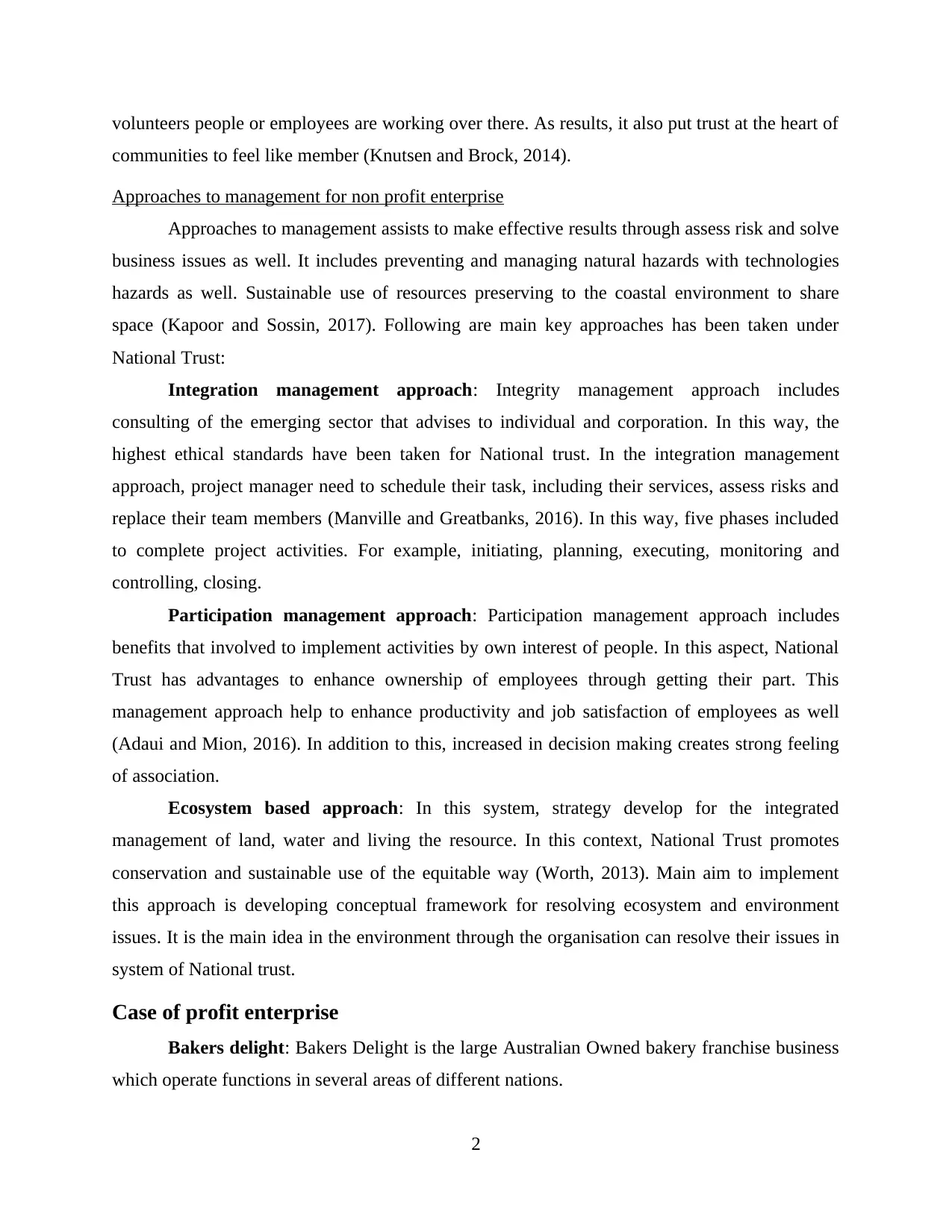
volunteers people or employees are working over there. As results, it also put trust at the heart of
communities to feel like member (Knutsen and Brock, 2014).
Approaches to management for non profit enterprise
Approaches to management assists to make effective results through assess risk and solve
business issues as well. It includes preventing and managing natural hazards with technologies
hazards as well. Sustainable use of resources preserving to the coastal environment to share
space (Kapoor and Sossin, 2017). Following are main key approaches has been taken under
National Trust:
Integration management approach: Integrity management approach includes
consulting of the emerging sector that advises to individual and corporation. In this way, the
highest ethical standards have been taken for National trust. In the integration management
approach, project manager need to schedule their task, including their services, assess risks and
replace their team members (Manville and Greatbanks, 2016). In this way, five phases included
to complete project activities. For example, initiating, planning, executing, monitoring and
controlling, closing.
Participation management approach: Participation management approach includes
benefits that involved to implement activities by own interest of people. In this aspect, National
Trust has advantages to enhance ownership of employees through getting their part. This
management approach help to enhance productivity and job satisfaction of employees as well
(Adaui and Mion, 2016). In addition to this, increased in decision making creates strong feeling
of association.
Ecosystem based approach: In this system, strategy develop for the integrated
management of land, water and living the resource. In this context, National Trust promotes
conservation and sustainable use of the equitable way (Worth, 2013). Main aim to implement
this approach is developing conceptual framework for resolving ecosystem and environment
issues. It is the main idea in the environment through the organisation can resolve their issues in
system of National trust.
Case of profit enterprise
Bakers delight: Bakers Delight is the large Australian Owned bakery franchise business
which operate functions in several areas of different nations.
2
communities to feel like member (Knutsen and Brock, 2014).
Approaches to management for non profit enterprise
Approaches to management assists to make effective results through assess risk and solve
business issues as well. It includes preventing and managing natural hazards with technologies
hazards as well. Sustainable use of resources preserving to the coastal environment to share
space (Kapoor and Sossin, 2017). Following are main key approaches has been taken under
National Trust:
Integration management approach: Integrity management approach includes
consulting of the emerging sector that advises to individual and corporation. In this way, the
highest ethical standards have been taken for National trust. In the integration management
approach, project manager need to schedule their task, including their services, assess risks and
replace their team members (Manville and Greatbanks, 2016). In this way, five phases included
to complete project activities. For example, initiating, planning, executing, monitoring and
controlling, closing.
Participation management approach: Participation management approach includes
benefits that involved to implement activities by own interest of people. In this aspect, National
Trust has advantages to enhance ownership of employees through getting their part. This
management approach help to enhance productivity and job satisfaction of employees as well
(Adaui and Mion, 2016). In addition to this, increased in decision making creates strong feeling
of association.
Ecosystem based approach: In this system, strategy develop for the integrated
management of land, water and living the resource. In this context, National Trust promotes
conservation and sustainable use of the equitable way (Worth, 2013). Main aim to implement
this approach is developing conceptual framework for resolving ecosystem and environment
issues. It is the main idea in the environment through the organisation can resolve their issues in
system of National trust.
Case of profit enterprise
Bakers delight: Bakers Delight is the large Australian Owned bakery franchise business
which operate functions in several areas of different nations.
2
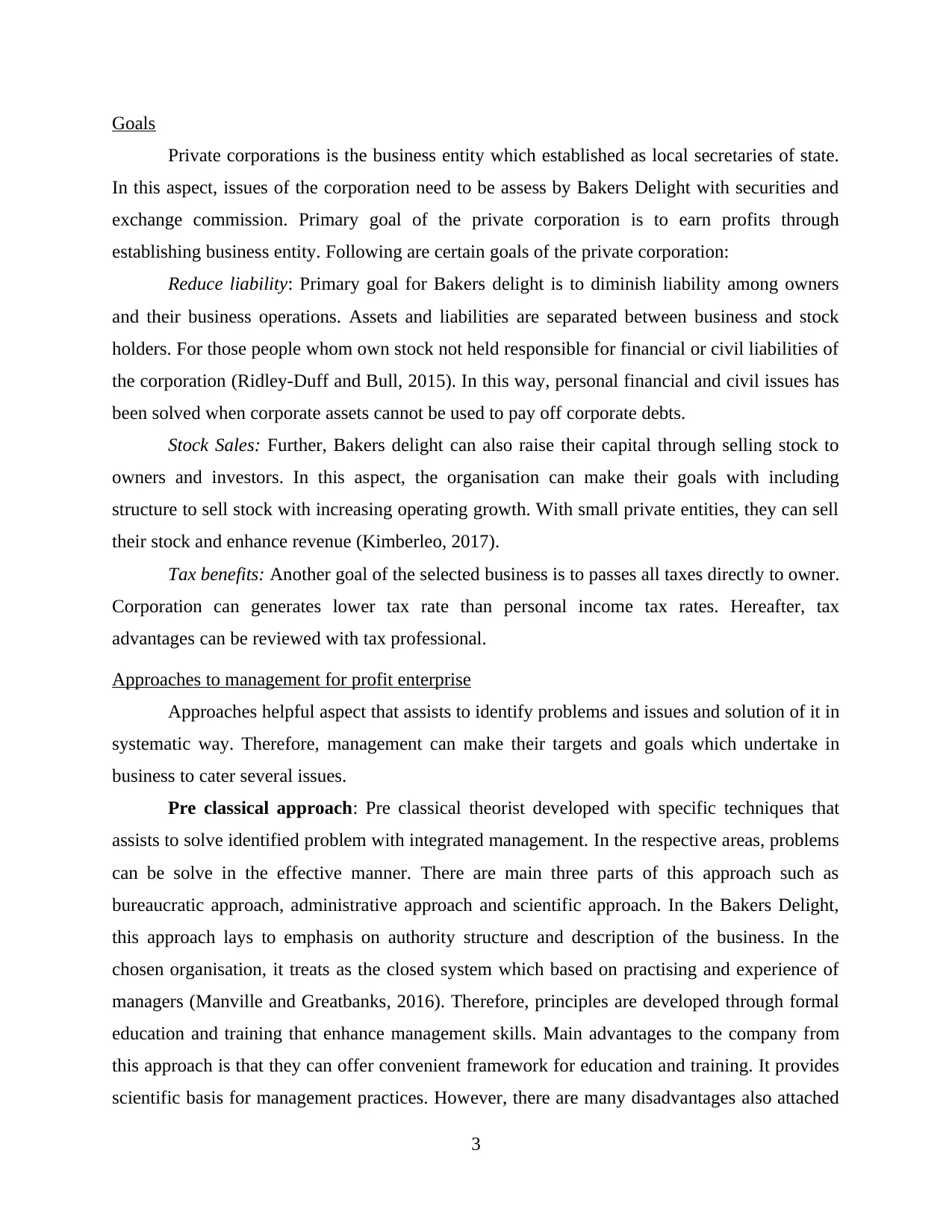
Goals
Private corporations is the business entity which established as local secretaries of state.
In this aspect, issues of the corporation need to be assess by Bakers Delight with securities and
exchange commission. Primary goal of the private corporation is to earn profits through
establishing business entity. Following are certain goals of the private corporation:
Reduce liability: Primary goal for Bakers delight is to diminish liability among owners
and their business operations. Assets and liabilities are separated between business and stock
holders. For those people whom own stock not held responsible for financial or civil liabilities of
the corporation (Ridley-Duff and Bull, 2015). In this way, personal financial and civil issues has
been solved when corporate assets cannot be used to pay off corporate debts.
Stock Sales: Further, Bakers delight can also raise their capital through selling stock to
owners and investors. In this aspect, the organisation can make their goals with including
structure to sell stock with increasing operating growth. With small private entities, they can sell
their stock and enhance revenue (Kimberleo, 2017).
Tax benefits: Another goal of the selected business is to passes all taxes directly to owner.
Corporation can generates lower tax rate than personal income tax rates. Hereafter, tax
advantages can be reviewed with tax professional.
Approaches to management for profit enterprise
Approaches helpful aspect that assists to identify problems and issues and solution of it in
systematic way. Therefore, management can make their targets and goals which undertake in
business to cater several issues.
Pre classical approach: Pre classical theorist developed with specific techniques that
assists to solve identified problem with integrated management. In the respective areas, problems
can be solve in the effective manner. There are main three parts of this approach such as
bureaucratic approach, administrative approach and scientific approach. In the Bakers Delight,
this approach lays to emphasis on authority structure and description of the business. In the
chosen organisation, it treats as the closed system which based on practising and experience of
managers (Manville and Greatbanks, 2016). Therefore, principles are developed through formal
education and training that enhance management skills. Main advantages to the company from
this approach is that they can offer convenient framework for education and training. It provides
scientific basis for management practices. However, there are many disadvantages also attached
3
Private corporations is the business entity which established as local secretaries of state.
In this aspect, issues of the corporation need to be assess by Bakers Delight with securities and
exchange commission. Primary goal of the private corporation is to earn profits through
establishing business entity. Following are certain goals of the private corporation:
Reduce liability: Primary goal for Bakers delight is to diminish liability among owners
and their business operations. Assets and liabilities are separated between business and stock
holders. For those people whom own stock not held responsible for financial or civil liabilities of
the corporation (Ridley-Duff and Bull, 2015). In this way, personal financial and civil issues has
been solved when corporate assets cannot be used to pay off corporate debts.
Stock Sales: Further, Bakers delight can also raise their capital through selling stock to
owners and investors. In this aspect, the organisation can make their goals with including
structure to sell stock with increasing operating growth. With small private entities, they can sell
their stock and enhance revenue (Kimberleo, 2017).
Tax benefits: Another goal of the selected business is to passes all taxes directly to owner.
Corporation can generates lower tax rate than personal income tax rates. Hereafter, tax
advantages can be reviewed with tax professional.
Approaches to management for profit enterprise
Approaches helpful aspect that assists to identify problems and issues and solution of it in
systematic way. Therefore, management can make their targets and goals which undertake in
business to cater several issues.
Pre classical approach: Pre classical theorist developed with specific techniques that
assists to solve identified problem with integrated management. In the respective areas, problems
can be solve in the effective manner. There are main three parts of this approach such as
bureaucratic approach, administrative approach and scientific approach. In the Bakers Delight,
this approach lays to emphasis on authority structure and description of the business. In the
chosen organisation, it treats as the closed system which based on practising and experience of
managers (Manville and Greatbanks, 2016). Therefore, principles are developed through formal
education and training that enhance management skills. Main advantages to the company from
this approach is that they can offer convenient framework for education and training. It provides
scientific basis for management practices. However, there are many disadvantages also attached
3
⊘ This is a preview!⊘
Do you want full access?
Subscribe today to unlock all pages.

Trusted by 1+ million students worldwide
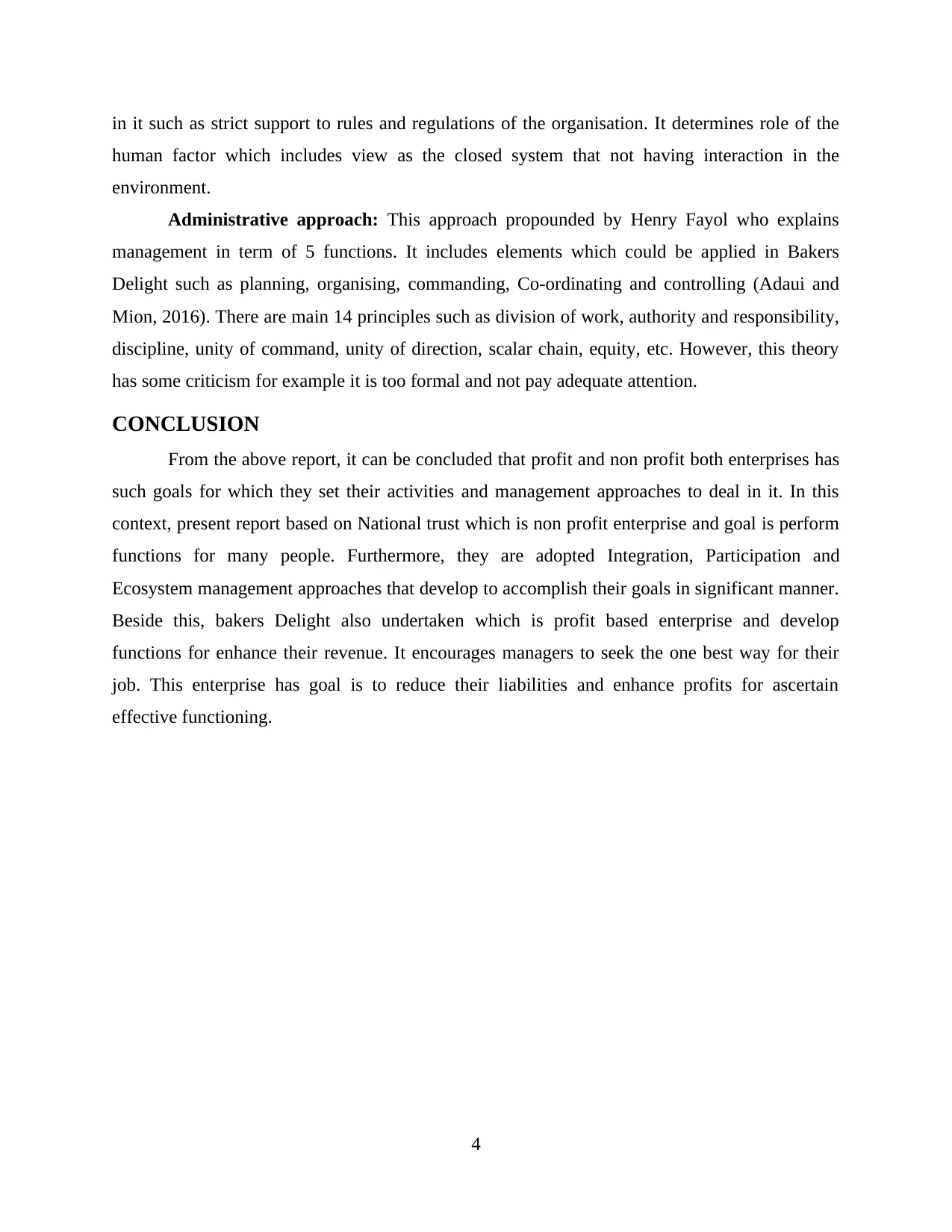
in it such as strict support to rules and regulations of the organisation. It determines role of the
human factor which includes view as the closed system that not having interaction in the
environment.
Administrative approach: This approach propounded by Henry Fayol who explains
management in term of 5 functions. It includes elements which could be applied in Bakers
Delight such as planning, organising, commanding, Co-ordinating and controlling (Adaui and
Mion, 2016). There are main 14 principles such as division of work, authority and responsibility,
discipline, unity of command, unity of direction, scalar chain, equity, etc. However, this theory
has some criticism for example it is too formal and not pay adequate attention.
CONCLUSION
From the above report, it can be concluded that profit and non profit both enterprises has
such goals for which they set their activities and management approaches to deal in it. In this
context, present report based on National trust which is non profit enterprise and goal is perform
functions for many people. Furthermore, they are adopted Integration, Participation and
Ecosystem management approaches that develop to accomplish their goals in significant manner.
Beside this, bakers Delight also undertaken which is profit based enterprise and develop
functions for enhance their revenue. It encourages managers to seek the one best way for their
job. This enterprise has goal is to reduce their liabilities and enhance profits for ascertain
effective functioning.
4
human factor which includes view as the closed system that not having interaction in the
environment.
Administrative approach: This approach propounded by Henry Fayol who explains
management in term of 5 functions. It includes elements which could be applied in Bakers
Delight such as planning, organising, commanding, Co-ordinating and controlling (Adaui and
Mion, 2016). There are main 14 principles such as division of work, authority and responsibility,
discipline, unity of command, unity of direction, scalar chain, equity, etc. However, this theory
has some criticism for example it is too formal and not pay adequate attention.
CONCLUSION
From the above report, it can be concluded that profit and non profit both enterprises has
such goals for which they set their activities and management approaches to deal in it. In this
context, present report based on National trust which is non profit enterprise and goal is perform
functions for many people. Furthermore, they are adopted Integration, Participation and
Ecosystem management approaches that develop to accomplish their goals in significant manner.
Beside this, bakers Delight also undertaken which is profit based enterprise and develop
functions for enhance their revenue. It encourages managers to seek the one best way for their
job. This enterprise has goal is to reduce their liabilities and enhance profits for ascertain
effective functioning.
4
Paraphrase This Document
Need a fresh take? Get an instant paraphrase of this document with our AI Paraphraser
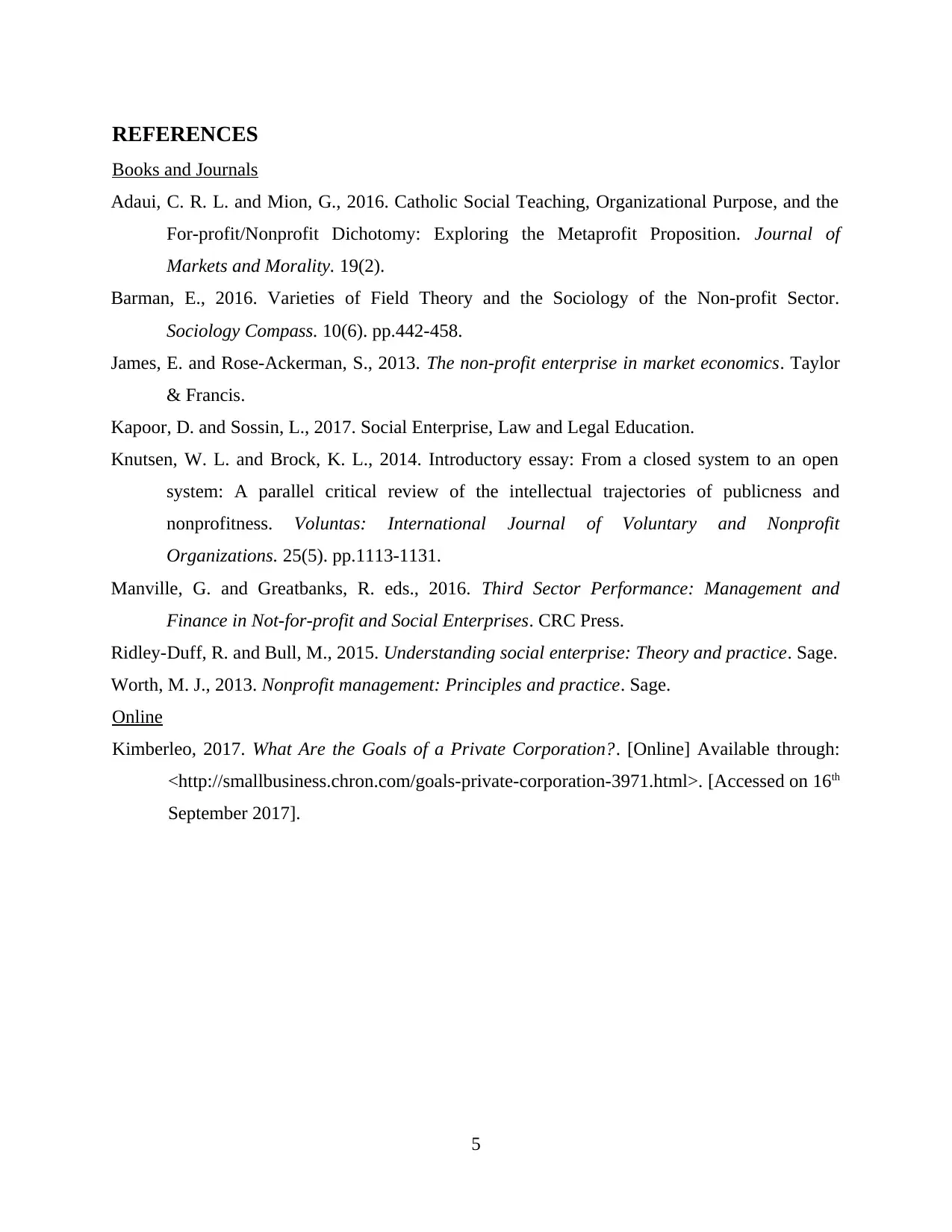
REFERENCES
Books and Journals
Adaui, C. R. L. and Mion, G., 2016. Catholic Social Teaching, Organizational Purpose, and the
For-profit/Nonprofit Dichotomy: Exploring the Metaprofit Proposition. Journal of
Markets and Morality. 19(2).
Barman, E., 2016. Varieties of Field Theory and the Sociology of the Non‐profit Sector.
Sociology Compass. 10(6). pp.442-458.
James, E. and Rose-Ackerman, S., 2013. The non-profit enterprise in market economics. Taylor
& Francis.
Kapoor, D. and Sossin, L., 2017. Social Enterprise, Law and Legal Education.
Knutsen, W. L. and Brock, K. L., 2014. Introductory essay: From a closed system to an open
system: A parallel critical review of the intellectual trajectories of publicness and
nonprofitness. Voluntas: International Journal of Voluntary and Nonprofit
Organizations. 25(5). pp.1113-1131.
Manville, G. and Greatbanks, R. eds., 2016. Third Sector Performance: Management and
Finance in Not-for-profit and Social Enterprises. CRC Press.
Ridley-Duff, R. and Bull, M., 2015. Understanding social enterprise: Theory and practice. Sage.
Worth, M. J., 2013. Nonprofit management: Principles and practice. Sage.
Online
Kimberleo, 2017. What Are the Goals of a Private Corporation?. [Online] Available through:
<http://smallbusiness.chron.com/goals-private-corporation-3971.html>. [Accessed on 16th
September 2017].
5
Books and Journals
Adaui, C. R. L. and Mion, G., 2016. Catholic Social Teaching, Organizational Purpose, and the
For-profit/Nonprofit Dichotomy: Exploring the Metaprofit Proposition. Journal of
Markets and Morality. 19(2).
Barman, E., 2016. Varieties of Field Theory and the Sociology of the Non‐profit Sector.
Sociology Compass. 10(6). pp.442-458.
James, E. and Rose-Ackerman, S., 2013. The non-profit enterprise in market economics. Taylor
& Francis.
Kapoor, D. and Sossin, L., 2017. Social Enterprise, Law and Legal Education.
Knutsen, W. L. and Brock, K. L., 2014. Introductory essay: From a closed system to an open
system: A parallel critical review of the intellectual trajectories of publicness and
nonprofitness. Voluntas: International Journal of Voluntary and Nonprofit
Organizations. 25(5). pp.1113-1131.
Manville, G. and Greatbanks, R. eds., 2016. Third Sector Performance: Management and
Finance in Not-for-profit and Social Enterprises. CRC Press.
Ridley-Duff, R. and Bull, M., 2015. Understanding social enterprise: Theory and practice. Sage.
Worth, M. J., 2013. Nonprofit management: Principles and practice. Sage.
Online
Kimberleo, 2017. What Are the Goals of a Private Corporation?. [Online] Available through:
<http://smallbusiness.chron.com/goals-private-corporation-3971.html>. [Accessed on 16th
September 2017].
5
1 out of 8
Related Documents
Your All-in-One AI-Powered Toolkit for Academic Success.
+13062052269
info@desklib.com
Available 24*7 on WhatsApp / Email
![[object Object]](/_next/static/media/star-bottom.7253800d.svg)
Unlock your academic potential
Copyright © 2020–2025 A2Z Services. All Rights Reserved. Developed and managed by ZUCOL.




